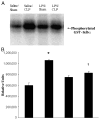Induction of endotoxin tolerance enhances bacterial clearance and survival in murine polymicrobial sepsis
- PMID: 18197145
- PMCID: PMC2754132
- DOI: 10.1097/shk.0b013e318162c190
Induction of endotoxin tolerance enhances bacterial clearance and survival in murine polymicrobial sepsis
Abstract
The fundamental mechanisms that underlie endotoxin tolerance remain to be elucidated, and the clinical significance of endotoxin tolerance in the context of active systemic infection remains in question. We hypothesized that the endotoxin tolerance phenotype would result in decreased inflammation at the expense of altered bacterial clearance and, thus, higher mortality in a murine model of polymicrobial sepsis induced by cecal ligation and puncture (CLP). Endotoxin tolerance was induced in C57Bl/6 mice with 5 mg/kg LPS or vehicle 18 h before subsequent CLP. Lung tissue, peritoneal fluid, and blood were collected at 1, 3, 6, and 18 h after surgery for subsequent analysis. Peritoneal macrophages were isolated for ex vivo phagocytosis assay. In separate experiments, mice were allowed to recover, and survival was monitored for 7 days. Endotoxin tolerance attenuated plasma TNF-alpha and IL-6 at 6 h after CLP. Peritoneal fluid cytokines were significantly attenuated as well. Endotoxin tolerance significantly improved bacterial clearance in both blood and peritoneal fluid after CLP. Similarly, ex vivo phagocytosis by primary peritoneal macrophages and RAW264.7 murine peritoneal macrophages was significantly improved after induction of the endotoxin tolerance phenotype. Contrary to our original hypothesis, we conclude that endotoxin tolerance significantly attenuates the host inflammatory response, augments bacterial clearance, and improves survival in this murine model of polymicrobial sepsis.
Figures








Similar articles
-
LPS pretreatment ameliorates multiple organ injuries and improves survival in a murine model of polymicrobial sepsis.Inflamm Res. 2011 Sep;60(9):841-9. doi: 10.1007/s00011-011-0342-5. Epub 2011 May 10. Inflamm Res. 2011. PMID: 21556916
-
Antibiotic treatment in a murine model of sepsis: impact on cytokines and endotoxin release.Shock. 2004 Feb;21(2):115-20. doi: 10.1097/01.shk.0000111828.07309.21. Shock. 2004. PMID: 14752283
-
Immune depression in polymicrobial sepsis: the role of necrotic (injured) tissue and endotoxin.Crit Care Med. 2000 Aug;28(8):2949-55. doi: 10.1097/00003246-200008000-00044. Crit Care Med. 2000. PMID: 10966277
-
BMAL2 promotes eCIRP-induced macrophage endotoxin tolerance.Front Immunol. 2024 Jun 13;15:1426682. doi: 10.3389/fimmu.2024.1426682. eCollection 2024. Front Immunol. 2024. PMID: 38938563 Free PMC article.
-
Granulocyte-macrophage-colony-stimulating factor-dependent peritoneal macrophage responses determine survival in experimentally induced peritonitis and sepsis in mice.Shock. 2008 Oct;30(4):434-42. doi: 10.1097/SHK.0b013e3181673543. Shock. 2008. PMID: 18277945 Free PMC article.
Cited by
-
Dichotomous engagement of HDAC3 activity governs inflammatory responses.Nature. 2020 Aug;584(7820):286-290. doi: 10.1038/s41586-020-2576-2. Epub 2020 Aug 5. Nature. 2020. PMID: 32760002 Free PMC article.
-
A quorum-sensing signal promotes host tolerance training through HDAC1-mediated epigenetic reprogramming.Nat Microbiol. 2016 Oct 3;1:16174. doi: 10.1038/nmicrobiol.2016.174. Nat Microbiol. 2016. PMID: 27694949 Free PMC article.
-
Endotoxin uptake in mouse liver is blocked by endotoxin pretreatment through a suppressor of cytokine signaling-1-dependent mechanism.Hepatology. 2009 May;49(5):1695-708. doi: 10.1002/hep.22839. Hepatology. 2009. PMID: 19296467 Free PMC article.
-
Finding new therapies for sepsis: the need for patient stratification and the use of genetic biomarkers.Crit Care. 2011;15(6):1009. doi: 10.1186/cc10527. Epub 2011 Dec 7. Crit Care. 2011. PMID: 22169064 Free PMC article.
-
The effects of CD14 and IL-27 on induction of endotoxin tolerance in human monocytes and macrophages.J Biol Chem. 2018 Nov 9;293(45):17631-17645. doi: 10.1074/jbc.RA118.003501. Epub 2018 Sep 21. J Biol Chem. 2018. PMID: 30242126 Free PMC article.
References
-
- Fan H, Cook JA. Molecular mechanisms of endotoxin tolerance. J Endotoxin Res. 2004;10:71–84. - PubMed
-
- Wolk K, Docke W, von Baehr V, Volk H, Sabat R. Comparison of monocyte functions after LPS- or IL-10–induced reorientation: importance in clinical immunoparalysis. Pathobiology. 1999;67:253–256. - PubMed
-
- West MA, Heagy W. Endotoxin tolerance: a review. Crit Care Med. 2002;30:S64–S73. - PubMed
-
- Cavaillon JM, Adrie C, Fitting C, Adib-Conquy M. Endotoxin tolerance: is there a clinical relevance? J Endotoxin Res. 2003;9:101–107. - PubMed
Publication types
MeSH terms
Substances
Grants and funding
LinkOut - more resources
Full Text Sources
Medical
Miscellaneous

